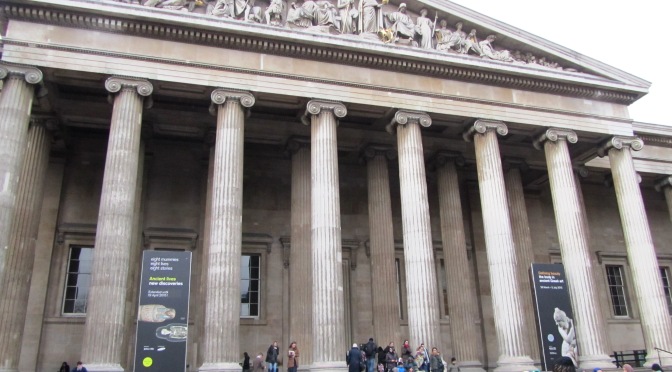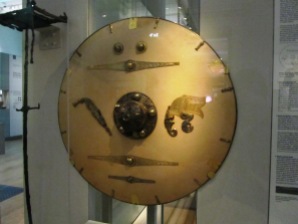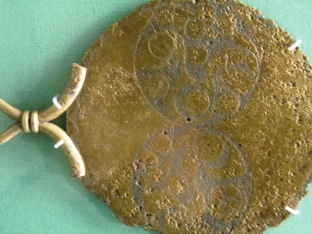Why fleeting you might ask? Well in a nutshell, the visit occured a couple of years ago during a whirlwind trip to London with the family and after a protracted visit to the Natural History Museum followed by getting distracted by a well known sci-fi shop I was left with a mere two and half hours to see the Museum…As some of you are well aware this is not nearly enough time and so it was, a fleeting visit. The following are a few of the photos I took along with brief explanations.
One of the first gallerys I made my way to was the early Medieval gallery – I had long wanted to see the artefacts from Mound 1 at Sutton Hoo, the famous Anglo-saxon ship burial. Sutton Hoo is located near Woodbridge in Suffolk and is the remains of a 6th and 7th century AD cemetary. Mound 1 was excavated in 1939 providing the world with a fascinating glimpse of the artistic ability of our Anglo-saxon forebears. The artefacts were richer and more intricate than any other found before.

Not far from the Sutton Hoo treasure is the Lewis Chessmen. These fascinating wee carvings were discovered in 1831 in Uig on the Isle of Lewis (Outer Hebrides). They are 12th century in date and carved from walrus ivory; it is believed they were originally made in Trondheim in Norway – at the time the Outer Hebrides were ruled by Norway. A number of years ago, a travelling exhibition on the Vikings came to the Auckland Museum in New Zealand. Two of the Lewis Chessmen accompanied the exhibition and it was this that inspired me to write “A Viking Moon”.

Staying with the Vikings we have the Cuerdale Hoard from Lancashire. The display at the museum is only part an enormous hoard of silver found in a lead chest beside the River Ribble. The hoard itself consisted of 7500 coins and 1200 pieces of silver bullion, weighing in at forty kilograms. The coins come from a variety of sources – mainly the eastern Viking kingdoms of England but also from King Alfred’s Wessex, Byzantium, Scandinavia, Islamic and Carolingian sources. The Ribble Valley was an important Viking route between the Irish Sea and York and this may have some bearing on why the hoard was found here.

Staying in the early Medieval my next photo is of the Burghead Bull. The town of Burghead in Moray, Scotland occupies part of what was once a Pictish promontory fort of great importance. The Burghead Bulls were discovered in the late nineteenth century when much of the fort was destroyed to make way for more houses. Originally there were thirty panels carrying carved images of bulls, now however, only six remain – one of which is held at the British Museum. They are dated to 5th century AD and it has been suggested they formed a frieze set into the ramparts of the fort and possibly represent a warrior cult which celebrated strength and aggression. Regardless of what the bull represents it is a fabulous piece of Pictish art.

Travelling back in time I moved onto the Roman and Iron Age galleries (this was a flying visit, I had just recieved a text from an impatient husband…)
In the Roman gallery I took a moment to admire a stone sarcophagus found in London in 1853 within what was described as an extensive Roman cemetary outside the city wall to the east. It is dated to the early 4th century AD.

Moving along swiftly I found myself in the British Iron Age and here I had to stop and admire the mirrors. Of all the artefacts from this period these are my favorite (and no its not because I have vain streak…). I have long held the belief that mirrors were more than a toilette item for these were never true mirrors that the modern person might be familiar with. Their surfaces were often burnished bronze and would at best reflect a fuzzy image. Instead I would suggest that the surface of a mirror acted in a similar way to the reflective surface of lake, pond or well providing access to the otherworld – a liminal space/place. Such places are well documented as being special, the vast numbersof artefacts found deposited into watery places at this time speaks for itself. Furthermore, it is surely no coincidence that later myths and stories use a mirror as a storytelling device (think Snow White).
Then of course something shiny caught my eye, first the Snettisham Torc and then the twisted gold torcs from the Ipswich Hoard. The Snettisham Torc was discovered in 1950 near the village of Snettisham in Norfolk. It is made up of a kilo of gold mixed with silver, there are 64 threads and each thread is 1.9mm wide, eight threads were pulled together and twisted then all were twisted again to make the torc. The terminal ends are hollow and were cast from a mould. The torc is dated to between 150BC and 50BC. The Ipswich Hoard was the second hoard to be found in the area, the first being Anglo-saxon in date. This particular hoard was discovered during the construction of a housing estate in 1968 by a digger driver and consisted of six twisted gold torcs. These torcs had less silver in them which has led the musuem to date their manufacture to around 75BC.
Finally I wound my way through the Egyptian gallery and down the stairs to meet up with the family who were marvelling at the large statues from the ancient world. The following is a selection of the photos from this part of the museum.
There was so much else to see but I simply ran out of time and as we were flying out the next day any other sight seeing would have to wait until another visit – although I have heard recently that there are plans afoot for a downloadable VR experience for those who can’t visit in person.
Below are a few links which relate to the above photos.
Sutton Hoo – The National Trust
List of Iron Age Hoards in Britain










